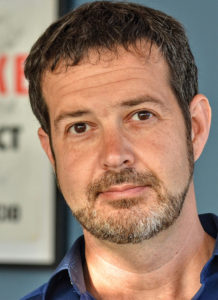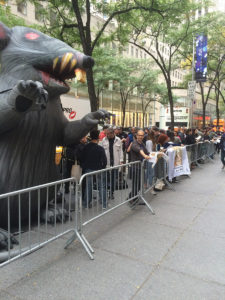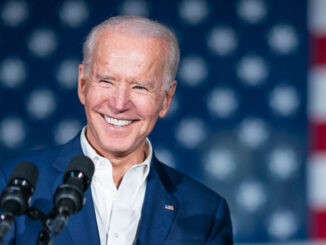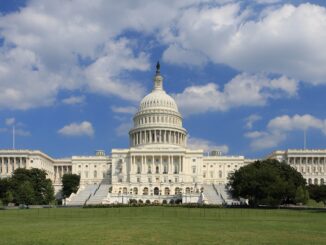
by Rob Callahan
Five years ago, I began a relationship with an unlikely companion.
We’re all familiar with the conventions of the buddy picture: A mismatched pair, thrown together by desperate circumstances, begrudgingly comes to respect, even admire each other. They transcend their differences, teaming up to tackle shared adversities and, in the process, forge a warm bond. Every plot twist, in retrospect, led inexorably to that moment like the one shared by Rick and Louis in Casablanca, side-by-side on the fog-blanketed tarmac: “I think this is the beginning of a beautiful friendship.”

I co-starred in one such story. My buddy, the star to whom I played sidekick, was a 12-foot tall inflatable rat.
Even if you didn’t walk the Shahs of Sunset picket line with your Guild sisters and brothers back in September 2014, you’ve probably seen Scabby the Rat. He is an enormous balloon in the shape of an ugly, menacing rodent reared up on its hind legs. For decades, the cartoonish creature has been a fixture at labor disputes in cities throughout the US, with unions erecting the balloon outside the premises of companies they accuse of exploitative employment practices.
Workplace abuses are ordinarily invisible to the general public, but Scabby’s raison d’être is to make such transgressions ostentatious. As an avatar of shameless greed, the inflatable rat has become a hallmark of campaigns to shame unscrupulous employers. The visual vocabulary of labor strife is less robust than that of motion pictures; in labor’s limited lexicon, few symbols register as potently as Scabby.
When Ryan Seacrest Productions, the producers of Shahs of Sunset, illegally retaliated against its post-production crew for organizing, the IATSE’s inflatable rat began a month-long residency on the sidewalk outside of the company’s Miracle Mile offices in LA. The Shahs strike was an extraordinarily long one for us — a four-week test of endurance that coincided, unfortunately, with a brutal heat wave. (Our strikes are ordinarily measured in increments of days or even hours, rather than weeks.) Scabby was with us all that time, standing sentry over our sun-parched picket lines. When hours of marching back and forth over 50 yards of scorched sidewalk rendered the rest of us picketers sweaty and weary, Scabby remained unflappable — except, of course, for those occasions when the blower keeping him inflated would falter, at which times he did literally flap.
(I write here of my personal relationship with Scabby, but it needs to be noted that my Guild colleague, Preston Johnson, and our IATSE brother, Ron Garcia, shared primary responsibility for husbandry of the rat. It was chiefly they who set him up each morning and broke him down at the end of each day’s picketing, and who tended to the sandbags, the air pump, the generator and his other miscellaneous needs. Scabby is a big-enough star to merit multiple sidekicks, and I played only a very minor role alongside him.)

Photo by Ron Garcia
Over the course of the Shahs fight, we even briefly deployed a second Scabby at Rockefeller Plaza to accompany members protesting outside of the headquarters of NBCUniversal. The New York incarnation of Scabby — with bloodshot eyes, yellow fangs, lolling red tongue and sharp, grime-crusted claws — was appreciably uglier than its West Coast doppelganger. It was apparent that our LA Scabby has had some work done.
I’m now reminded of my time with Scabby because our friend has been in the news of late. The National Labor Relations Board (NLRB), currently dominated by President Donald Trump’s appointees hostile to organized labor, appears intent upon branding the balloon an outlaw. Observers of the NLRB attribute the Board’s war on Scabby to NLRB General Counsel Peter Robb, whose monomaniacal prosecution of the giant rodent rivals Captain Ahab’s cetological obsession. The General Counsel, according to a senior NLRB official quoted anonymously in Bloomberg Law earlier this year, “hates the rat.”
Months ago, Robb reportedly instructed NLRB lawyers to find cases that could be used to overturn a 2011 ruling protecting unions’ use of Scabby. Earlier this summer, he tried and failed to get a judge to bar a union from deploying inflatable rats outside of several Staten Island supermarkets.
Robb will likely prevail, though, before a management-friendly Board in a case involving the International Brotherhood of Electrical Workers (IBEW) and its demonstration outside of a hotel in Philadelphia last summer. At issue is the question of whether the balloon’s presence effectively constitutes an illegal secondary boycott. (The hotel didn’t directly employ individuals represented by IBEW, but was under fire from the union for using a non-union contractor.) An administrative law judge ruled in favor of Scabby, but that case now heads to the Board for review, and the General Counsel’s office has submitted a brief full of points intended to puncture the rat’s legal defenses.
If this brouhaha sounds more than a little bit silly, it is. We’re talking about a high-ranking government official on a crusade against a cartoon balloon. It is as if Inspector Javert had opted to pursue not Jean Valjean, but instead Pepé Le Pew. Absurdities aside, however, the fight has real implications for how we think about the rights of workers to push for better working conditions.
I never went to law school, and chances are most of you didn’t either. But anybody with a middle school education knows that the First Amendment guarantees freedom of expression. And Scabby, with his exaggerated snarl and beady, hate-filled eyes, is clearly expressive. In short, Scabby is speech. Any move by a government agency to prohibit non-violent protest would run afoul of this first principle in the Bill of Rights, right?
No, say the NLRB’s lawyers. Their argument turns on subtle distinctions between speech and conduct, between protest and picketing, between persuasion and coercion. An op-ed imploring employers to pay a living wage would be well and good, but a non-violent demonstration outside of a company hiring non-union contractors is breaking the law — at least if an oversized cartoon rodent is involved.
Ultimately, Robb and others who would outlaw Scabby are able to make straight-faced arguments to curb peaceful protest because US labor law is in fact rooted not in the First Amendment’s guarantees of liberties, but instead in the Constitution’s Commerce Clause, the language authorizing Congress to regulate trade. Indeed, the opening paragraphs of the National Labor Relations Act (NLRA), the legal underpinning for collective bargaining in the private sector, make explicit that the law “safeguards commerce from injury, impairment or interruption, and promotes the flow of commerce by removing certain recognized sources of industrial strife and unrest.”

Although the text of the NLRA makes passing reference to the freedom of association, those individual and collective freedoms are not its focus. Instead of asserting that workers have a fundamental and inalienable right to come together to advance their shared interests, the law makes the more prosaic case that efficient collective bargaining keeps the gears of the economy well-oiled.
In 1935, when the NLRA was first passed, pragmatism may have shaped lawmakers’ choice to ground their legislation upon narrow concerns of commercial efficiency rather than profound principles of inherent rights, but that choice has helped to shape 84 years of jurisprudence that is hostile to workers. In “Labor’s Bill of Rights,” a 2017 report for the Century Foundation, Shaun Richman, the Program Director of the Harry Van Arsdale, Jr. Center for Labor Studies at SUNY Empire State College, writes that the decision to ground the NLRA in the Commerce Clause “has the perverse effect of judging worker rights — which are human rights concerns — within the frame of impact on business to the exclusion of free speech and other considerations… [I]n such a framework, the courts will tend to have more sympathy for business interests.”
The NLRB’s lawyers make this framework — and its implications — explicit in their case against Scabby. A brief filed in the Philadelphia case by one of Robb’s underlings contains a section titled “The Government Is Justified in Restraining Certain Speech to Protect the Free Flow of Commerce.” She writes therein: “Given the [NLRA]’s purpose to protect the free flow of interstate commerce, there is an inherent recognition that the speech and conduct of both employers and unions that the Act regulates constitutes [sic] the type of commercial speech that is entitled to lesser constitutional protections.” By categorizing what unions do as “commercial speech” (akin to advertising), Robb and company seek to deny unions robust First Amendment protection. Your right to swing your arms ends just where someone else’s nose begins, and your right to a rat-shaped balloon ends just where it potentially impedes interstate commerce.
Richman and others have argued that labor should reject this legal framework within which our rights have been boxed and make a strategic decision to challenge management-friendly labor laws and regulations on constitutional grounds. Perhaps the NLRB’s prosecution of Scabby will invite just such a challenge, one that could even call into question the longstanding prohibition on secondary boycotts and picketing. As a phoenix rises from its own ashes, perhaps labor’s speech rights will ultimately rise up from the rubbery heap of a deflated rat.
Perhaps, but let’s not hold our breath as the air hisses out of our oversized friend.
Over the course of our time together on the picket line, I developed a soft spot for the big lunk but, in truth, it wasn’t Scabby that won the Shahs strike for us. And I feel passionately about the freedom of speech, but I know that neither symbols nor words contain the true source of our strength.
We won the fight for Shahs just like we win every other victory: through the commitment co-workers make to stick together and through the resolve of the broader community that coalesces to support them. Ryan Seacrest Productions ultimately capitulated and brought its editorial crew back to work under a union contract because talented artists and craftspeople had proven that they would stand together, and that the company couldn’t make their product without our members’ skills.
Notwithstanding the contentions of a bunch of anti-union lawyers in the NLRB or anywhere else, the messages to which unions give voice aren’t “commercial speech”; they’re fighting words. As more folks come to recognize which side they’re on in such fights, we will prevail, whatever the law might have to say about our balloon buddies.






